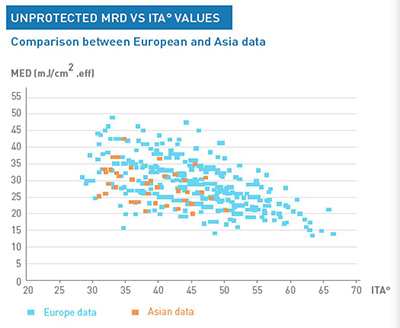Introduction
IDEA services are proposed to companies on an international basis with customers all over the world. Many of them, from Asian countries as well as from Europe and the US, ask naturally that their products be tested on Asian panelists.
In order to fulfil this demand, IDEA Tests Group recently opened a solar testing facility in Bangkok (Thailand).
The international guidelines for the determination of SPF (ISO 24444 Standard, FDA final rule 2011, International Method 2006) recommend the use of different skin types based on the Fitzpatrick’s classification, i.e. type I, II and III. In addition, the ISO 24444 Standard recommends the use of a mix of the 3 skin types. The skin of Asian people is characterised by various points, among them the skin type that is mainly close to III, rather than I or II. In addition, the determination of skin type could be uncertain by the fact that most Asian subjects, particularly in the cities, avoid sun exposure and therefore cannot provide to the physician the elements to assess their individual sensitivity to UV.
The cosmetic industry, is now faced with this question: how to be compliant with the international guidelines for SPF testing?
The aim of this work is to focus on this point, to show how compliance could be an issue in the SPF determination on Asian panelists and to propose ways to answer the question.
Background
The current reference methods used for the SPF determination of a cosmetic product are:
- The ISO 24444 standard published in 2010 (for Europe, Australia/New Zealand, South America, Japan, South Africa;
- The final FDA rule published in 2011 (for USA and Canada); and
- The international COLIPA method of May 2006 (for some Asian countries that have not yet adopted the ISO 24444 method).
For each of these methods, the selection of subjects participating in the study is primarily or exclusively based on skin type. This classification is based on the erythemal and pigmentation response of the skin, after 2 hours exposure for the first summer exposure, just after winter. It was developed by Fitzpatrick in 1975 for the predictive factor of the skin reactivity for the PUVA photo-chemotherapy.
This classification is given in table 1.
This classification is now widely used for dermatological purpose to estimate the risk of the onset of skin cancer and for selection of volunteers for the sun protection factor determination (table 2).

The 3 reference methods request to perform the test with volunteers with skin type I, II and III as described in table 2. ISO 24444 and COLIPA international methods also authorise the use of the Individual Topological Angle (ITA°), based on the chromametric measurement in the CIE L*a*b*system.
In addition ISO 24444 standard recommends that the volunteers do not have the same skin type in one panel.
The Individual Typology Angle ITA° is calculated as follows:

For Caucasians and under temperate climate, this evaluation is relevant. However, this can be questioned for Asian people, for which skin types I and II are exceptions, and even more in regions with tropical or subtropical climates where the ‘end of winter’ is meaningless.
Results
All data were obtained on volunteers exposed to the UV using Xenon pulsed arc simulators (Multiport 300W, Solar Light Co Ltd, Glenside, PA, USA).
We compared the historical data obtained in our Centre in Europe with those recently obtained in our Centre in Bangkok (table 3).
All the data collected are coming from volunteers included in SPF determination studies. Therefore, a mix of skin types I, II and III are used in Europe, but only skin types III were included in Bangkok: it was not possible to find skin types I or II.
The average erythemal sensitivity of the Asian panel is similar to that of the average Caucasian panel (based on all the volunteers where skin types I are a minority).
Typological data of the 2 panels (see graph) show that the erythemal sensitivity according to ITA° are quite superimposable except for European data with ITA° > 55° corresponding to very light skin, who are mostly skin types I and some skin types II.

Graph 1: Unprotected MED vs ITA˚ values
Conclusion
The selection of volunteers by measuring ITA° angle presents the advantage of being based on an objective measurement and maintains equal relevance whatever the climate, compared with a selection based on the skin type. Its use should therefore be preferred, and especially in the case of Asian-type panels. The selection by the ITA° keeps the concept of ‘mixing’, leaving the option to set the proportion from very clear skin to clear skin and intermediate skin. Its implementation as the main inclusion criterion, appears to us desirable in future updates of the current Standards. ISO 24444:2010, even though it appears to give prominence to skin type, can be interpreted fortunately as implicitly authorising the selection of volunteers based solely on ITA°. It should be of a great interest to clarify the relevant sections for the next revision in 2015/2016.
For more information, please contact Virginie RIBIERE: v.ribiere@groupeideatests.com
Christophe Courbière, Frédéric Nunzi and Anne Casoli
IDEA Tests Group, Site Montesquieu, 33650 Martillac – France




